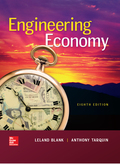
Calculate incremental
Explanation of Solution
Table-1 shows the cash flow (Values are in 1,000 units).
Table -1
| Alternative | T | I |
| First cost (F) | -5,000 | -6,500 |
| AOC (AC) per year | -1,000 | -650 |
| Expected revenue (R) per year | 2,500 | 2,500 |
| Salvage value (SV) | 100 | 200 |
| Time period (n) | 5 | 5 |
MARR is 25%.
Incremental rate of return of alternatives T and Do nothing can be calculated as follows:
Substitute the incremental rate of return as 15% by trial-and-error method in the above equation.
The calculated value is greater than the present value of the incremental first cost. Thus, increase the incremental rate of return to 15.65%.
The calculated value is nearly equal to the incremental present value. Thus, it is confirmed that the incremental rate of return is ~15.65%. Since the incremental rate of return is less than MARR, reject the alternative T and select the do nothing.
Incremental rate of return of alternatives I and Do nothing can be calculated as follows:
Substitute the incremental rate of return as 13% by trial-and-error method in the above equation.
The calculated value is greater than the present value of the incremental first cost. Thus, increase the incremental rate of return to 13.72%.
The calculated value is nearly equal to the incremental present value. Thus, it is confirmed that the incremental rate of return is 13.72%. Since the incremental rate of return is less than MARR, reject the alternative I and select do nothing.
Want to see more full solutions like this?
Chapter 8 Solutions
Engineering Economy

 Principles of Economics (12th Edition)EconomicsISBN:9780134078779Author:Karl E. Case, Ray C. Fair, Sharon E. OsterPublisher:PEARSON
Principles of Economics (12th Edition)EconomicsISBN:9780134078779Author:Karl E. Case, Ray C. Fair, Sharon E. OsterPublisher:PEARSON Engineering Economy (17th Edition)EconomicsISBN:9780134870069Author:William G. Sullivan, Elin M. Wicks, C. Patrick KoellingPublisher:PEARSON
Engineering Economy (17th Edition)EconomicsISBN:9780134870069Author:William G. Sullivan, Elin M. Wicks, C. Patrick KoellingPublisher:PEARSON Principles of Economics (MindTap Course List)EconomicsISBN:9781305585126Author:N. Gregory MankiwPublisher:Cengage Learning
Principles of Economics (MindTap Course List)EconomicsISBN:9781305585126Author:N. Gregory MankiwPublisher:Cengage Learning Managerial Economics: A Problem Solving ApproachEconomicsISBN:9781337106665Author:Luke M. Froeb, Brian T. McCann, Michael R. Ward, Mike ShorPublisher:Cengage Learning
Managerial Economics: A Problem Solving ApproachEconomicsISBN:9781337106665Author:Luke M. Froeb, Brian T. McCann, Michael R. Ward, Mike ShorPublisher:Cengage Learning Managerial Economics & Business Strategy (Mcgraw-...EconomicsISBN:9781259290619Author:Michael Baye, Jeff PrincePublisher:McGraw-Hill Education
Managerial Economics & Business Strategy (Mcgraw-...EconomicsISBN:9781259290619Author:Michael Baye, Jeff PrincePublisher:McGraw-Hill Education





